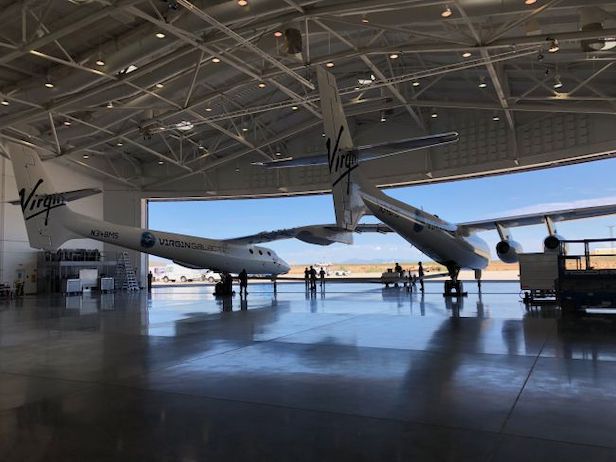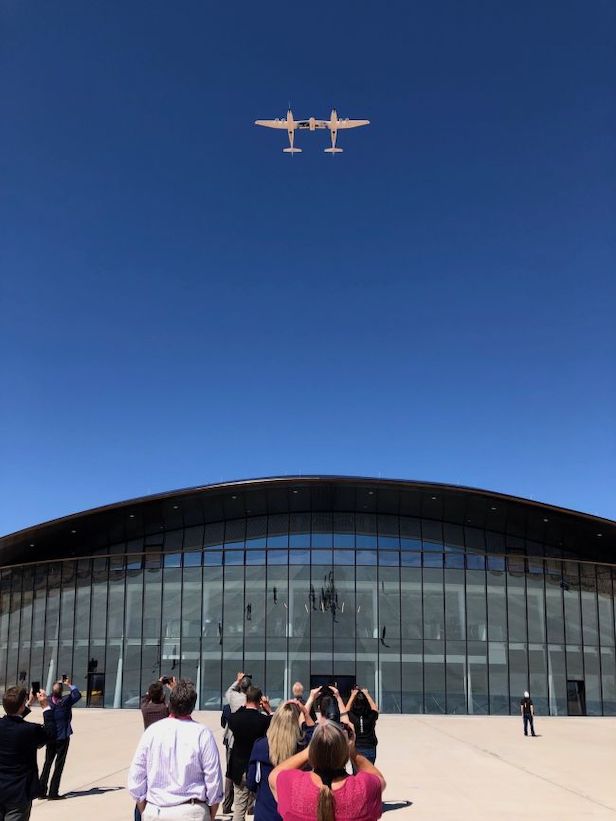Virgin Galactic inaugurated its ‘Gateway to Space’ by flying ‘Eve’ over Spaceport America
VMS Eve flew from its refurbished home base for the first time on 15 August 2019

In the hangar at Virgin Galactic’s “Gateway to Space” building at Spaceport America, which can accommodate two WhiteKnightTwo carrier planes and five SpaceShipTwo vehicles simultaneously. Image credit: Space.com/Mike Wall
Virgin Galactic’s newly refurbished home base now has a flight under its belt.
The spaceflight company, which aims to start launching paying customers to suborbital space in the near future, declared its “Gateway to Space” building here operational on 15 August 2019.
During a media event, Virgin Galactic showed off the completed interiors of the structure’s first and second floors, which house communal social areas and the spaceflight-operations sector, respectively. (The third floor, which will harbour an astronaut lounge, should be done in the next few months, company representatives said.)
Yesterday’s festivities included a flight by VMS Eve, the carrier aircraft that hauls the six-passenger VSS Unity space plane to an altitude of about 15,000 metres (50,000 feet). At that point, Unity drops free and engages its rocket motor, powering itself upward. (“VMS” stands for “Virgin Mother Ship,” by the way, and “VSS” for “Virgin Spaceship.”)
Eve and Unity have flown many test missions together over the past few years. The most recent two liftoffs – in December 2018 and February of this year – saw Unity reach suborbital space, earning four Virgin Galactic pilots and chief astronaut instructor Beth Moses their commercial astronaut wings.

Virgin Galactic’s VMS Eve carrier aircraft flies over the company’s “Gateway to Space” building at Spaceport America in New Mexico United States, on 15 August 2019. Image credit: Space.com/Mike Wall
Those flights all originated from the Mojave Air and Space Port in southern California, United States, where Virgin Galactic’s test program was based. But after the back-to-back spaceflight successes in December and February, the company announced that the test campaign’s final phases would take place here in southern New Mexico, the site of Virgin Galactic’s future commercial operations. (More than 600 people have already booked a ride to suborbital space with the company; a ticket currently costs £205,000/$250,000.)
Eve flew alone yesterday – Unity remains in Mojave, getting its cabin touched up – but the 90-minute flight was no stunt. Virgin Galactic wanted to give pilot Kelly Latimer and co-pilot Mark “Forger” Stucky more familiarity with southern New Mexico’s airspace and landscape, and to make sure there was solid data exchange between Eve and mission control, among other objectives.
And things went well, team members said.
“All of that looked really, really good today,” Virgin Galactic flight director Bill Kuhlemeier told reporters shortly after Eve touched down.
Eve has flown such solo sorties from Spaceport America before, but not since 2016, said Virgin Galactic president Mike Moses. And yesterday’s flight was the first to use the newly installed mission control centre.
“Every other time, we brought a trailer of stuff with us,” Moses told Space.com, referring to the temporary mission control the team had to set up here.
“The big change is, home is here now,” he added. “That’s a big mental shift for the team.”
Eve will perform a few more flights here over the coming weeks, Moses said. Sometime in the next few months, the carrier plane will fly back to Mojave, grab Unity, and haul the spacecraft here to its new home.
VMS Eve is the first of Virgin Galactic’s carrier planes, which go by the generic name WhiteKnightTwo. VSS Unity, meanwhile, is the second of the SpaceShipTwo space planes flown by the company.
The first, VSS Enterprise, broke apart during a rocket-powered test flight in October 2014, a tragic accident that killed co-pilot Michael Alsbury and wounded pilot Peter Siebold. Investigators traced the cause to Enterprise’s “feathering” re-entry system, which was deployed too early in the flight. Virgin Galactic redesigned SpaceShipTwo to ensure the same problem would not happen with VSS Unity or any other future spaceships.
And Unity will have company, if all goes according to plan. Two additional SpaceShipTwo vehicles are currently being built, and one of them should be ready to start test flights next year, Moses said. The two in production have informal internal names, he added, but Virgin Galactic isn’t ready to tell us what they are.
“They’re Serial Nos. 3 and 4 for now,” he said.
The Gateway to Space can accommodate these planned vehicles and more. The cavernous hangar that occupies the building’s centre space can fit two WhiteKnightTwos and five SpaceShipTwos simultaneously, Virgin Galactic representatives said.
Keep up to date with the latest news in All About Space – available every month for just £4.99. Alternatively you can subscribe here for a fraction of the price!




